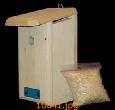The
bird family of Titmice includes 65 species, twelve in North America.
These familiar birds include chickadees as well as the Tufted and Plain
Titmouse.
They are
hole or cavity nesters and take readily to nest boxes. They are
small, friendly birds, common at feeders, and the sexes look alike.
Tufted Titmouse
The Tufted
Titmouse ranges over nearly the entire eastern half of the US, excluding
only the northernmost border and the southernmost tip of Florida. It
is sparrow-sized, gray above and white below with a rust color on its
sides and a gray crest. A small black patch can be seen just above
the beak, and its large black eyes give it an inquisitive look. Its
cousin, the Black-crested Titmouse, dwells in Texas, has a black crest,
and is otherwise the same bird.
This
little gray fellow is a permanent resident throughout its range, living in
deciduous woods, preferably near swamps and riversides. They are
largely insectivorous, but in winter much of their diet may consist of
berries, nuts and seeds. They are fond of peanut kernels, sunflower
seeds, and suet at feeders. They also like little pieces of white
bread.
Plain Titmouse
The Plain
Titmouse is the western cousin and lives in the southwestern states.
It is a small, gray bird with a crest, but it is all gray, without the
rust or white accents.
Both birds
hunt for insects by clinging to branches of trees and shrubs and peering
into the crevices of the bark. They sometimes forage on the ground
as well.
Their
calls are similar, a whistled "peter, peter, peter."
Bridled Titmouse
A less
common variety, the Bridled Titmouse, is found only in the mountains of
southern Arizona and New Mexico and has a small black bib and black
"eyeliner" on its face. It has a call like the chickadee's.
Titmice
are not afraid of people, making them a common inhabitant of gardens and
back yards. They are curious little fellows and will sometimes perch
on a window ledge and peer into your house to see what's going on.
Titmice
nest in the cavities of trees, in either natural holes or in abandoned
woodpecker holes. Sometimes they excavate a hole themselves in
rotting wood.
They may
be attracted to a nesting box by placing nesting material nearby, such as
hair (human or combed from a cat or dog), fur, feathers and thread (no
more than 3" to 4" long). Their breeding season is from March to
July. The female does all the nest building, but the male may keep
her company. He will bring her food when she is incubating her
eggs.
The nest
may contain 4 to 8 white eggs with brown speckles. They hatch in
13-16 days, and after another 15 to 18 days the little birds leave the
nest. Adults will raise one, possibly two, broods per year.
The
nesting box should be placed on a tree or fence post in semi-shade, about
5' to 10' off the ground, in a suburban area with a mixture of trees and
open areas.





 Coveside Slate Squirrel Guard
Coveside Slate Squirrel Guard
 Coveside Titmouse/Warbler/Swallow Bird House
Coveside Titmouse/Warbler/Swallow Bird House
 Coveside Wood Chips Nesting Material
Coveside Wood Chips Nesting Material Coveside Wood Predator Guard
Coveside Wood Predator Guard

 Woodside Gardens
The Registry of Nature Habitats
Woodside Gardens
The Registry of Nature Habitats 
 1999 -
1999 -